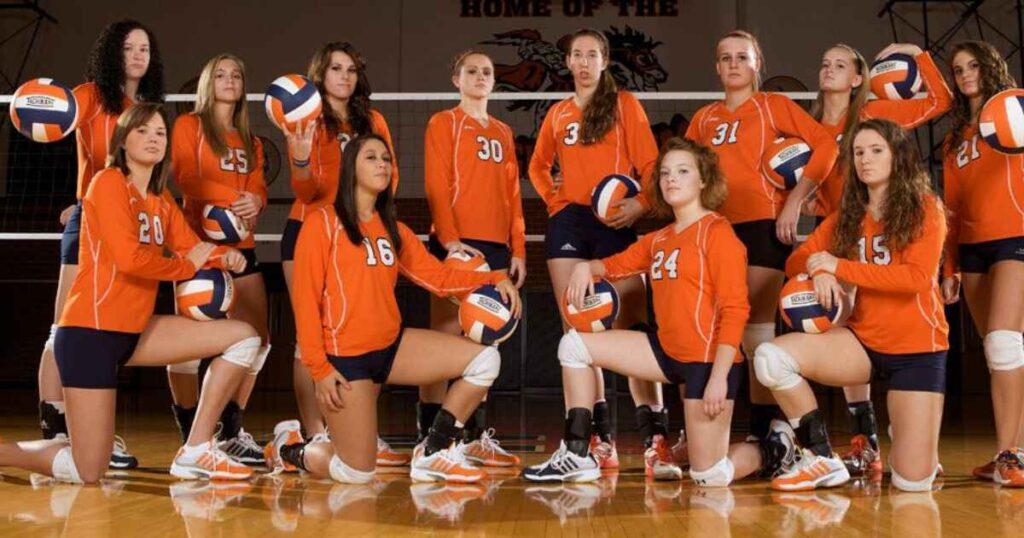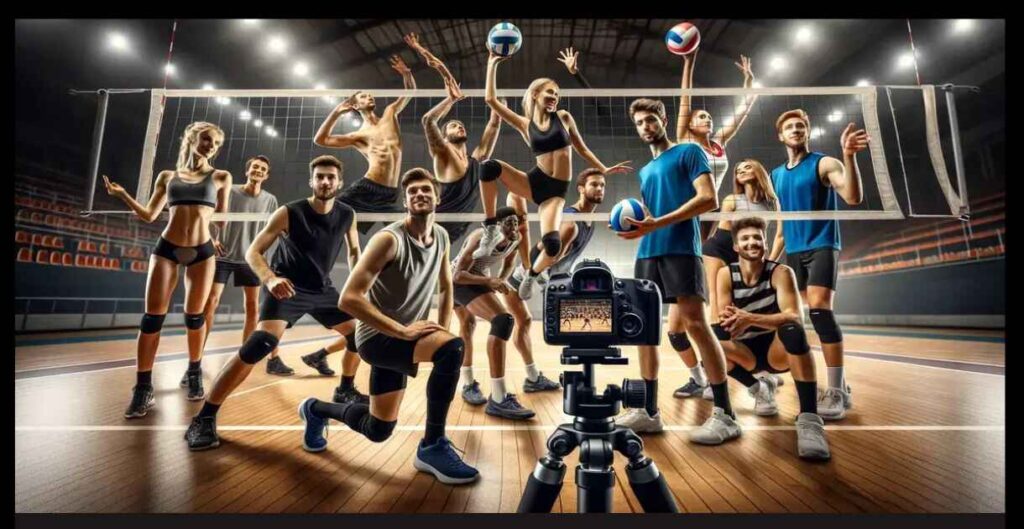Poses for volleyball pictures in 2024 are necessary for showcasing the excitement and strength of the game. Whether it’s a powerful spike, a well timed block, or a celebratory little time after a point, the right pose captures the soul of your athleticism and love for the sport.
This year, as social media continues to play a significant part in how we share our lives, nailing the ideal volleyball pose can build your photos stand out and leave an enduring impression. With everyone looking to capture their best game moments, understanding the most useful poses for volleyball pictures is key.
These poses highlight your skill, energy, and the competitive spirit that explain the sport. Whether you’re a seasoned player or just enjoying a relaxed game on the beach, the right pose can turn an usual photo into a memorable snapshot of your volleyball journey. Let’s jump right in and find how to capture the best volleyball action moments in 2024!
Equipment Essentials
When it comes to volleyball photography, having the just gear can construct or break your shots. It’s not just about pointing and shooting; it’s regarding having the tools that will help you capture each obey , spike, and celebration in exceptional detail.
Let’s dive into the equipment required that will set you up for success on the court. From choosing the ideal camera to understanding the nuances of shutter speed, we will cover everything you need to know to build your volleyball photography kit.
Remember, while gear is main , it’s your eye for the game and quick reflexes that’ll truly build your photos shine. So, let’s gear up and get prepared to snap some unforgettable volleyball action!
See Also: Beach Volleyball Outfit: Perfect Gear for Fun in the Sun in 2024
Choosing the Right Camera
When selecting a camera for volleyball photography, focus on models with fast autofocus and high support per second (FPS). A DSLR or mirrorless camera with at least 7 FPS will help you catch quick movements.
Look for cameras with good low-light performance, as numerous gyms have demanding lighting conditions. Consider choices like the Canon EOS R6 or Nikon Z6 II for their very good autofocus and burst shooting ability.
Selecting Lenses for Volleyball Photography
For volleyball pictures, versatility is key. A 70-200mm f/2.8 lens is ideal for catch close-up steps from the sidelines. Pair this with a 24-70mm f/2.8 for extensive court shots and team photos.
If you’re on a budget, a 50mm f/1.8 prime lens can make sharp images and beautiful bokeh, mainly for portraits of players. Remember, fast lenses (with wide apertures) are pivotal for indoor games.
Understanding Shutter Speed
Shutter speed is critical in freezing volleyball steps. For crisp shots of fast in motion players and balls, aim for at least 1/500th of a second, or even speedly it possible. In well-lit outdoor courts, you force push this to 1/1000th or beyond.
However, in dimmer indoor settings, you’ll need to balance shutter speed with ISO and aperture. Do not be afraid to experiment with slower speeds for creative motion blur results on serves or dives.
Fundamentals of Volleyball Photography
Mastering the essentials of volleyball photography is like study to set the ideal ball. It takes practice, but once you have got it down, you are unstoppable. In this section, we’ll travel over the pivotal camera settings that will help you freeze those lightning-speedy spikes and the place secrets that will give you the best point of sight points for every play.
Whether you’re shooting inside or out, these tips will help you catch the strength and grace of the game. We’ll cover each item from nailing your focus to working with difficult gym lighting. Get ready to elevate your sports photography game and produce images that truly catch the spirit of volleyball!
Camera Settings for Action Shots
To capture remarkable action shots, start with a wide opening (f/2.8 to f/4) to isolate players from the background. Set your ISO based on available light do not be afraid to go higher in dim gyms, as present day cameras hold noise well.
Use constant autofocus (AF-C) and burst manners to track moving subjects. For white balance, auto normally works well, but you can use a traditional setting for consistent colors over all your shots.
Positioning for Optimal Coverage
Great volleyball photography is all about places. For serving shots, stand close by the baseline, a little offset from the server. During rallies, move along the sidelines to capture dissimilar angles.
Try shooting from a low angle to make players be seen more powerful, or from the stands for an overview of the court. Always be aware of your environment and respect the boundaries set by officials and venue rules.
Capturing the Excitement

There’s nothing quite like the thrill of a volleyball match, the soaring spikes, the lightning fast place, and the team celebrations that make the horde go wild. As a photographer, your job is to bottle up that excitement and serve it to the watcher by your lens.
In this section, we will find how to capture those heart stopping little times that define the game. From expect the ideal shot to freezing mid-air action, we’ll protect the techniques that will help you create images split open with energy and emotion.
Get ready to learn how to tell the story of the game by your volleyball pictures and conduct the excitement of the court to life!
Tips for Action Shots
To nail those epic action shots, expectation is key. Watch the players’ motion and learn to forecast when the big moments will happen. Use burst mode to capture a series of images, increasing your possibilities of getting the model frame.
Focus on players’ faces to transport emotion, and don’t forget to catch the strength of serves, the grace of sets, and the ability of spikes. Experiment with dissimilar angles to add variation to your portfolio.
Photographing Serve and Defense
When shooting serves, pivot on the player’s form and close attraction. Capture the little while just before contact with the ball for greatest tension. For defensive plays, be ready for quick movements.
Diving saves and blocks make for good images. Use a fast screen speed to freeze players in mid-air. Do not forget to catch team reactions after a great defensive play – these emotional little times can be just as powerful as the step itself.
See Also: Volleyball Tryout Drills: Essential Exercises for Selection Success in 2024
Post-Processing and Editing
After the game’s last whistle blows, your work as a volleyball photographer is far from over. Post-processing and improvement are where your volleyball pictures honestly come to life. This is your possibility to increase the drama of a mid-air spike, bring out the power in a player’s eyes, or create a cohesive look for your whole portfolio.
In this section, we’ll dive into the necessary editing techniques that will take your photos from good to great. We’ll cover each item from basic adjustments to modren tricks that’ll build your images pop. Remember, editing is an art form in itself, so do not be afraid to experiment and grow your own style!
Basics of Photo Editing
Start your editing procedure with basic adjustments like exposure, contrast, and color balance. Use the crop tool to make better composition and detach distractions. For indoor shots, noise depletion can help clean up high-ISO images.
Adjust white balance to right any color casts from gym lighting. Remember, subtle adaptation often shields the best results if you want your volleyball photos to look natural and correct to the moment.
Enhancing Your Volleyball Pictures
To make your volleyball pictures pop, try selective sharpening on key areas like players’ faces and the ball. Experiment with black and white conversions for dramatic effect, especially for intense action shots.
A subtle vignette can draw attention to the central action. Consider using presets or developing your own to create a consistent look across your volleyball portfolio. Always aim to enhance, not drastically alter, the original image.
Sharing and Promotion
You’ve captured remarkable volleyball action and shiny our images to perfection now it’s time to part your work with the world! In the digital age, knowing how to successfully share and encourage your volleyball photography is just as important as taking great shots.
This section will guide you by the best practices for showcasing your work on communal media and structure a standout portfolio. We’ll explore how to use platforms like Instagram and Facebook to get your photos in front of the right viewers, and discuss a master plan for building a reputation as a go-to volleyball . Get prepared to learn how to make your photos go viral and attract awareness from teams, players, and publications!
Best Practices for Social Media
To make your volleyball pictures shine on social media, focus on consistency and engagement. Post regularly, using relevant hashtags like Volleyball Photography and Sports Action.
Optimize your images for each platform Instagram prefers square crops, while Twitter favors landscape orientations. Engage with the volleyball community by tagging players, teams, and venues. Share behind-the-scenes content and photography tips to build a loyal following.
Building a Portfolio
A strong portfolio is crucial for any aspiring sports photographer. Choose your absolute best shots, showcasing a variety of actions, emotions, and compositions. Choose your absolute top shots, showcasing a variation of actions, emotions, and compositions. Consider using platforms similar to Squarespace or Adobe Portfolio to create a professional looking website.
Include a mix of action shots, painting , and team photosDon’t forget to highlight any work you’ve done for specific teams or publications. Regularly update your portfolio with your latest and greatest volleyball action shots to keep it fresh and relevant.
My Top 3 Poses for Volleyball Pictures

After years of capturing volleyball steps, I’ve found that sure poses consistently produce remarkable images. Here are my top three picks for poses that will build your volleyball pictures stand out:
- The Sky-High Spike: Capture the attacker at the peak of their jump, arm tilt back, ready to let loose a powerful spike. This pose showcases the sport man vertical leap and the strength of the moment.
- The Diving Save: Focus on a player fully extended, parallel to the ground, fingers just grazing the ball. This dramatic pose highlights the player’s agility and determination.
- The Team Celebration: Catch the entire team in an over joined huddle after scoring a pivotal point. This pose captures the friendship and emotion that make volleyball such an exciting sport.
Remember, timing is everything when you catch these poses. Use burst mode and expect the action to increase your possibilities of nailing the perfect shot
FAQs
How do you take pictures of volleyball players?
Capture action shots by focusing on players’ movements and timing your shots with key moments like spikes or serves.
Where do you stand for volleyball photography?
Position yourself near the court sidelines or behind the baseline to get dynamic angles of the players.
What is the best angle for volleyball photography?
The best angle is low and from the side, capturing the height and intensity of jumps and hits.
What lens for Volleyball?
Use a 70-200mm lens for versatile zoom and sharp action shots in volleyball photography.


